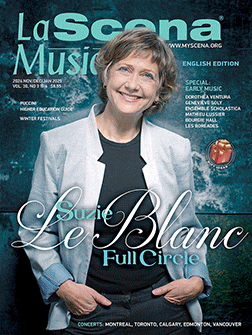In May 2015, visibly frail, the august Nikolaus Harnoncourt stood before his Concentus Musicus Wien and directed two Beethoven symphonies in a reading that followed closely what the composer had written in his score. If Beethoven gave a primitive horn an impossible low D to play, that’s how Harnoncourt wanted it played and not, as others do, switched it to the bassoon. It’s a vital question, he said at the time, of “whether it is possible to achieve your goals.” Harnoncourt and his Concentus had spent their lives together trying to achieve a literal understanding of great art, written by…
Browsing: Lebrecht Weekly
What can New York expect of its next music director? Jaap van Zweeden’s recordings can be counted on your fingers and most are – like this release with the Dallas Symphony – live concerts. Mahler’s third symphony is a large and unwieldy piece with a mezzo soloist and women’s and children’s choruses, a test of organisation for any conductor before he or she can begin to think about interpretation. On first hearing, this performance is efficient and attractive with sustainable speeds and some fetching solos from the concertmaster, Alexander Kerr. The vocal soloist Kelley O’Connor lacks heft and any dimensiom…
Slower even than one-horse EMI, Deutsche Grammophon was the last label of consequence to adopt stereo recording in the late 1950s. Its circumspection is, in retrospect, comprehensible. In austerity-minded Germany, a second living-room speaker would have been deemed an anti-social luxury and DG’s mono quality was, by any criterion, world-class. Under the leadership of camp-survivor Elsa Schiller, DG had buried its Nazi past beneath a blaze of new talent and high performance. The DG represented in this massive box of rarities is a label under post-War reconstruction, fascinating in its rigour and frugality. This is DG in the age before…
The question is, what took them so long? Martha Argerich and Daniel Barenboim, born a year apart in Buenos Aires to Jewish mothers of Russian extraction, have left it until their mid-seventies to discover common ground. Both prodigious pianists, they sailed for Europe where their paths diverged. Argerich won the Busoni and Chopin competitions and worked intensively with Italian conductors, notably Abbado, Muti, Sinopoli and Chailly. Barenboim determined from an early age to be an orchestral conductor. He had no need for other pianists. When he put on a concerto he could play it himself (or call in his mentor,…
Most composer reputations subside in the generation after their death. It’s as if posterity calls time out while deciding its final judgement. Witold Lutoslawski is a notable exception to this hiatus rule. Since his death in 1994, performances of his music have become more frequent and his status has risen steadily among both modernists and conservatives. A Pole living under Stalinism, Lutoslawski was adept at facing both ways without sacrificing his creative principles. He wrote works of dangerous aleatory freedom and others of completely conventional form. All bore his unmistakable elegance. The Concerto for Orchestra, premiered in 1954, was acclaimed…
You knew that the author of Doctor Zhivago was a composer, right? You didn’t. Well sit back; this might take a while. One of the most iconic portraits of the mystical Russian musician Alexander Scriabin was painted by the distinguished arstist, Leonid Pasternak. The sitter so impressed the artist’s 14 year-old son that Boris Pasternak promptly decided to become a composer and went to study for a while at the Moscow Conservatoire. Six years later he gave up writing music, but Scriabin’s influence proved formative and enduring, especially on his poetry. Boris Pasternak later married the wife of the important…
Viennese masters, always short of cash, picked up commissions from rich British tourists for composing drawing-room settings of national heritage. Haydn and Beethoven filled their boots with Scottish and Welsh ballads for two ducats a song. Haydn wrote about 200, dressed up with piano, violin and cello accompaniments. Easy money. The first surprise in this absorbing recital by Christian Gerhaher is that he sings the Haydn ditties in German, in a 1920s translation. It’s disconcerting at first but gradually deepens with hints of the nearness of these simple sentiments to the core topics of German Lieder: springtime, love and loss.…
After two years of creative trauma that silenced almost every leading composer, the latter half of the First World War yielded works of extraordinary intimacy. Claude Debussy, responding to a terminal diagnosis of rectal cancer, wrote three intense sonatas for varied instruments and piano. In the last concert of his life, in September 1917, Debussy accompanied Gaston Poulet in the violin sonata, a work of fizzing energy, utterly lacking lament or regret. Gone is Debussy’s distancing feline detachment. The sonata closes on a ‘very animated’ springlike dance, a smiling might-have-been. Debussy died in March 1918, within sound of German gunfire,…
An unknown work by Benjamin Britten sets the pulse racing. It turns out to be fragments of a concerto he started writing for Benny Goodman in 194. What with Pearl Harbour and Peter Grimes, it got pushed to the back of the desk. Before Britten sailed home to England in March 1942, the only finished movement was seized by US Customs was seized on suspicion that it contained espionage codes. The movement did not see light of day until 1989 when it was retrieved and orchestrated by Colin Matthews, Britten’s composing assistant, and premiered by the clarinet virtuoso Michael Collins.…
Yannick Nézet-Séguin’s interpretation of Mahler’s first symphony is beautifully played by Munich’s (some say Germany’s) best orchestra and thoughtfully structured by an impressive guest conductor. I think I am safe in saying that it is conceptually different from any of the 120 Mahler Firsts on record, stretching all the way back to Dmitri Mitropolous’s towering Minnesota performance for Columbia in April 1940. And that’s no small distinction in a much-repeated piece. Where Yannick differs from all others is in atmospherics. The opening four and a half minutes of ambient sound, where the ear searches for a clue to what’s going…












